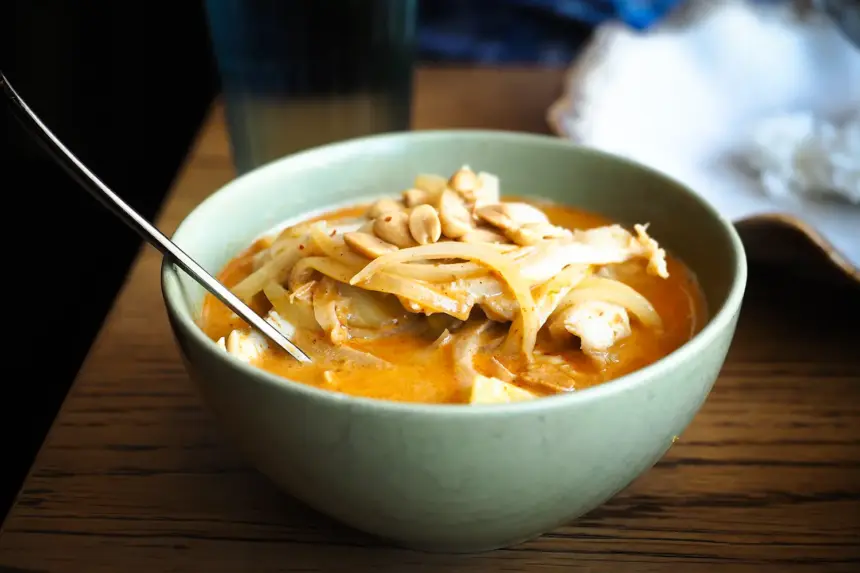Thai Food: Massaman Curry – A Fusion of Cultures and Flavors
Massaman Curry (แกงมัสมั่น) is one of Thailand’s most beloved and unique dishes, with a flavor profile that sets it apart from other Thai curries. This rich, aromatic dish is a harmonious blend of influences from Thai, Malay, Indian, and even Persian cuisines, which has earned it a special place not only in Thai culture but also on the international culinary stage. Massaman curry is a comforting dish with tender meat, creamy coconut milk, a medley of warm spices, and a hint of sweetness, making it a must-try for anyone eager to explore the diverse flavors of Thai food.
In this article, we will delve into the history, ingredients, preparation methods, and cultural significance of Massaman Curry, examining what makes this dish so exceptional.
The Origins and History of Massaman Curry
Massaman curry’s origins are as rich and complex as its flavors. It is widely believed that the dish was influenced by Persian and Muslim traders who traveled through Thailand during the 17th century, particularly during the reign of King Narai. The term “Massaman” itself is thought to derive from the word “Mussulman,” an old term for Muslims. These traders brought with them spices and cooking techniques that were unfamiliar to Thai cuisine at the time, such as the use of dry spices like cinnamon, cloves, and cardamom.
Unlike traditional Thai curries, which rely heavily on fresh herbs and chilies, Massaman curry incorporates these dried spices, lending the dish a more subtle, earthy warmth rather than the sharp heat typical of Thai food. Over time, Thai chefs adapted these foreign influences, blending them with local ingredients such as coconut milk, lemongrass, and tamarind to create the distinctive Massaman curry we know today.
Despite its foreign roots, Massaman curry has become a quintessential part of Thai cuisine, often served at celebrations and special occasions. It’s a dish that represents Thailand’s openness to new ideas, ingredients, and culinary traditions, creating a fusion that is both exotic and comforting.
Essential Ingredients in Massaman Curry
What sets Massaman Curry apart from other Thai curries is its use of rich, aromatic spices combined with typically Thai ingredients like coconut milk and tamarind paste. Here is a breakdown of the key ingredients that make this dish so distinctive:
- Meat: Traditionally, Massaman curry is made with beef or chicken, although lamb, duck, and even pork can also be used. Beef is often preferred because its flavor and texture work well with the long, slow cooking process that the dish requires. The meat becomes tender and absorbs the complex flavors of the curry paste and spices.
- Massaman Curry Paste: The curry paste is the heart of the dish, made from a blend of traditional Thai ingredients like lemongrass, galangal, garlic, and shallots, combined with imported spices such as cumin, coriander seeds, cinnamon, cardamom, cloves, and nutmeg. This combination gives Massaman curry its distinctive taste, which is less spicy but more fragrant and slightly sweet compared to other Thai curries like green or red curry.
- Coconut Milk: As with many Thai curries, coconut milk forms the base of the sauce, providing a creamy, rich texture that balances the heat of the spices and the tanginess of the tamarind. The coconut milk adds a subtle sweetness to the dish, which is a key element in Massaman curry’s overall flavor profile.
- Potatoes: Massaman curry typically includes large chunks of potatoes, which absorb the flavors of the curry and provide a hearty, satisfying element to the dish. Potatoes are not commonly found in other Thai curries, making this a distinctive feature of Massaman curry.
- Peanuts: Another distinguishing feature of Massaman curry is the addition of peanuts, either whole or crushed. The peanuts provide a subtle nutty flavor and add a crunchy texture that contrasts nicely with the tender meat and soft potatoes.
- Tamarind Paste: Tamarind adds a tangy, sour note to the dish, balancing the sweetness from the coconut milk and sugar. This ingredient is key to achieving the complex balance of flavors that make Massaman curry so unique.
- Palm Sugar: Palm sugar is used to sweeten the curry and balance the sour and salty elements. It has a rich, caramel-like flavor that deepens the overall taste of the dish.
- Fish Sauce: Fish sauce is a staple in Thai cuisine and is used to add saltiness and umami to the dish. It complements the sweetness of the palm sugar and the sourness of the tamarind, helping to create the perfect balance of flavors.
- Lime Leaves: Kaffir lime leaves are often used as a garnish in Massaman curry, adding a fresh, citrusy aroma that brightens the richness of the dish.
The Flavor Profile of Massaman Curry
The flavor profile of Massaman Curry is unlike any other Thai curry, thanks to its intricate blend of Thai and Indian-inspired spices. Here are some of the key flavor characteristics of the dish:
- Sweetness: The coconut milk, palm sugar, and peanuts provide a natural sweetness that makes Massaman curry mild compared to the spicy heat of other Thai curries.
- Spiciness: While Massaman curry is not as hot as other Thai curries, it still has a gentle heat, thanks to the curry paste’s use of dried chilies. The spiciness is subtle and balanced by the sweetness of the coconut milk and sugar.
- Sourness: Tamarind paste adds a tangy, sour flavor that balances the richness of the coconut milk and the sweetness of the palm sugar. This sour note is essential to the dish’s flavor complexity.
- Earthiness: The use of spices like cinnamon, cloves, and cardamom gives the curry a warm, earthy undertone that is reminiscent of Indian or Middle Eastern cuisine. These spices are uncommon in traditional Thai dishes, adding to Massaman curry’s distinctive flavor.
- Creaminess: The rich, velvety texture of the curry comes from the coconut milk, which creates a smooth, creamy base that coats the meat and potatoes.
How to Prepare Massaman Curry
Preparing Massaman Curry may seem intimidating because of the long list of ingredients, but the process is straightforward once you gather everything. The key to a successful Massaman curry is slow-cooking the meat so it becomes tender and flavorful. Here’s a simplified version of the preparation process:
- Making the Curry Paste: If you want to make the curry paste from scratch, you’ll need to blend or pound the ingredients (chilies, garlic, shallots, lemongrass, galangal, and spices) into a fine paste. However, pre-made Massaman curry paste is widely available in Thai supermarkets, and it’s a great alternative for those short on time.
- Cooking the Meat: Brown the meat (usually beef or chicken) in a bit of oil, then remove and set aside.
- Simmering the Curry: Add the curry paste to the pot and sauté until fragrant. Then add coconut milk and let it simmer before returning the meat to the pot.
- Adding the Aromatics: Add tamarind paste, fish sauce, palm sugar, and spices like cinnamon sticks and cardamom pods. Let the curry simmer slowly, allowing the meat to tenderize and the flavors to meld.
- Incorporating Potatoes and Peanuts: Add the potatoes and peanuts to the curry and continue cooking until the potatoes are soft and the sauce has thickened.
- Final Touches: Garnish the curry with kaffir lime leaves and serve hot with steamed rice.
Variations of Massaman Curry
While the classic beef Massaman curry is the most common version, there are several variations depending on personal preference and regional influences. Some of these include:
- Chicken Massaman Curry: Chicken is often used as an alternative to beef, and it cooks faster while still absorbing the rich flavors of the curry paste and coconut milk.
- Lamb Massaman Curry: In some regions, lamb is used for a more Middle Eastern-inspired twist on the traditional dish. The tender, fatty meat pairs beautifully with the warm spices in the curry.
- Vegetarian Massaman Curry: For a vegetarian version, you can substitute the meat with tofu or a variety of vegetables such as pumpkin, sweet potatoes, or carrots. The use of mushrooms can also add a meaty texture to the dish.
The Cultural Significance of Massaman Curry
Massaman curry holds a special place in Thai cuisine because of its historical roots and unique flavor profile. It’s often regarded as a dish served at celebrations and special occasions, reflecting its status as a luxurious and hearty meal.
Although it originated from foreign influences, Massaman curry is considered a true Thai dish today, embodying Thailand’s ability to adapt and merge diverse culinary traditions. Its warm spices and slow-cooked meat make it a comforting, family-friendly dish that appeals to a wide range of palates.
In fact, Massaman curry has earned international recognition, even being named the “World’s Best Food” by CNN in 2011. Its rich, aromatic flavor continues to win over food lovers around the globe.
Conclusion: Why Massaman Curry is a Must-Try
Massaman Curry is a standout dish in Thai cuisine, offering a unique blend of sweet, spicy, sour, and creamy flavors that come together in perfect harmony. Its historical roots, complex ingredients, and luxurious taste make it a must-try for anyone interested in Thai food.
Whether you’re enjoying a bowl in Thailand or at a local Thai restaurant, Massaman curry offers a glimpse into the rich cultural fusion that defines Thai cuisine. With its tender meat, creamy sauce, and aromatic spices, it’s a dish that is sure to leave a lasting impression on your taste buds.










